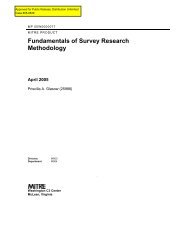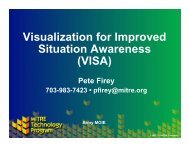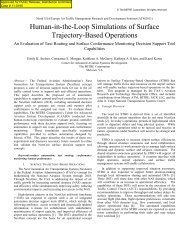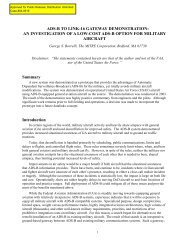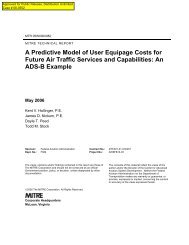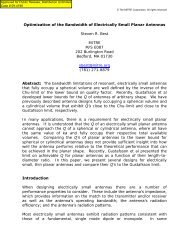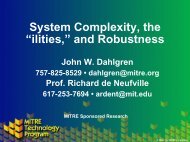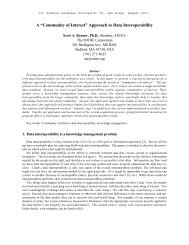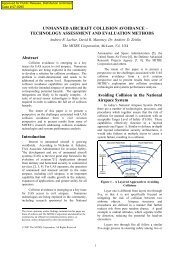Tactical Edge Characterization Framework: Volume 3 ... - Mitre
Tactical Edge Characterization Framework: Volume 3 ... - Mitre
Tactical Edge Characterization Framework: Volume 3 ... - Mitre
Create successful ePaper yourself
Turn your PDF publications into a flip-book with our unique Google optimized e-Paper software.
MTR080310<br />
MITRE TECHNICAL REPO RT<br />
<strong>Tactical</strong> <strong>Edge</strong> <strong>Characterization</strong> <strong>Framework</strong><br />
<strong>Volume</strong> 3: Evolution and Application of the<br />
<strong>Framework</strong><br />
September 2008<br />
Dr. Fatma Dandashi<br />
Dr. Priscilla Glasow<br />
Dr. David Kaplan<br />
Weber Lin<br />
Salim Semy<br />
Jennifer Valentine<br />
Dr. Beth Yost<br />
Sponsor: OSD (NII) Contract No.: W15P7T-08-C-F600<br />
Dept. No.: E543 Project No.: 0708ECSE-DA<br />
The views, opinions and/or findings contained in this report are those of<br />
The MITRE Corporation and should not be construed as an official<br />
Government position, policy, or decision, unless designated by other<br />
documentation.<br />
2008 The MITRE Corporation. All Rights Reserved.<br />
Approved for Public Release; Distribution Unlimited<br />
Case Number: 09-0166
Executive Summary<br />
Many approaches commonly used to develop a Service-Oriented Environment (SOE) presume<br />
the availability of reliable, consistently available networks that provide significant bandwidth<br />
and little to no latency. Since this is often not the case across the Department of Defense’s (DoD)<br />
networks, the current development methods might not provide reliable capability to users in a<br />
<strong>Tactical</strong> <strong>Edge</strong> (TE) environment. 1 This Enterprise Systems Engineering (ESE) Capstone activity<br />
aims to ensure the viability of a SOE to a broader domain of tactical users by gaining a better<br />
understanding of the TE and quantifying its characteristics.<br />
During Fiscal Year (FY) 2007, the ESE Capstone activity developed a <strong>Tactical</strong> <strong>Edge</strong> <strong>Framework</strong><br />
(TEF). The primary objectives of the TEF are 1) to provide a classification of disadvantaged<br />
users (i.e., users operating in a TE environment), and 2) to provide a common vocabulary to<br />
characterize TE environments. The common vocabulary allows the TE characteristics to be<br />
quantified and solutions to be identified to explicitly address the quantified characteristics. As<br />
the DoD’s components deliver services to the TE, the TEF’s common vocabulary and use of<br />
consistent solutions will promote interoperability across component-specific implementations.<br />
The TEF was documented in two papers; “Common Vocabulary for <strong>Tactical</strong> Environments”,<br />
which defines a common vocabulary that identifies classes of disadvantaged users at the TE and<br />
characterizes their environments as a set of constraints [2], and “Design Patterns for <strong>Tactical</strong><br />
Environments,”, which describes a set of repeatable solutions (i.e., design patterns) to mitigate<br />
the common TE constraints [3].<br />
The focus of the FY 2008 activity was to socialize the TEF and facilitate its transition to the<br />
DoD. The socialization of the TEF across the DoD’s components and the component’s<br />
commands resulted in the validation and evolution of the TEF. The TEF’s evolution included<br />
incorporating Central Command’s (CENTCOM) characterization of the tactical edge into the<br />
TEF, as described by the “Disadvantaged User” white paper, and tailoring the TEF to better<br />
incorporate the DoD’s component-specific perspectives of the TE. Furthermore, the common<br />
vocabulary from the TEF was aligned with authoritative definitions of terms from joint<br />
publications based on work completed by the Core Enterprise Services to the <strong>Tactical</strong> <strong>Edge</strong><br />
(CESTE) Focus Group.<br />
Another focus of the FY 2008 activity was to apply the TEF across multiple DoD programs to<br />
demonstrate its value. The TEF was applied throughout the service acquisition lifecycle, from<br />
the collection of users’ requirements, to documenting use cases, to the design and development<br />
of a service. TEF’s applicability was also demonstrated in managing the portfolio of services at<br />
the TE. The TEF was employed by:<br />
Special Operations Command’s (SOCOM) <strong>Tactical</strong> Local Area Network in interviewing<br />
users at <strong>Tactical</strong> Special Operations Centers to collect functional requirements and usage<br />
patterns.<br />
1 <strong>Tactical</strong> edge is defined by Defense Information Systems Agency (DISA) as anything beyond the Defense Information Systems<br />
Network Point-of-Presence.<br />
iii
Net-Enabled Command Capability (NECC) program office to characterize Disconnected,<br />
Intermittent, and Limited environments.<br />
CESTE Focus Group to develop Performance and Service Reference Models and<br />
departmental guidance for delivering Core Enterprise Services into and throughout the<br />
TE.<br />
Net-Centric Enterprise Solutions for Interoperability (NESI) to define characteristics of<br />
TEF classes of environments’ such that relevant and tailored NESI guidance and best<br />
practices can be identified for each class of TE environment.<br />
As we reflect on the lessons learned from the ESE Capstone activity and consider future setups<br />
to support the realization of services to the TE, we believe that use of the TEF should be further<br />
institutionalized at a departmental level. In support of this, we recommend the following:<br />
Joint Staff and doctrinal leads from the components should adopt the TEF to establish<br />
DoD-wide definitions for the classes of TE environments and use the TEF’s common<br />
vocabulary to characterize them.<br />
The DoD Chief Information Officer and the Net-Centric (NC), Command and Control,<br />
and Battlespace Awareness Capability Portfolio Managers should employ the TEF to<br />
define Service and Performance Reference Models in order to establish an NC Enterprise<br />
Architecture.<br />
Defense Information Systems Agency’s Net-Centric Enterprise Services and NECC, in<br />
conjunction with the DoD’s component-specific Programs of Record developing<br />
enterprise services (e.g., Consolidated Afloat Networks and Enterprise Services, Army<br />
System-Of-Systems Common Operating Environment, Marine Corps Enterprise<br />
Information Technology Services, and Air Force’s Air and Space Operations Center as a<br />
Weapon System) should use the TEF to define and document interfaces and design<br />
patterns to achieve federation and meet Quality of Service requirements across DoD<br />
component-specific TE platforms.<br />
The adoption of a common characterization of the TE and the use of consistent design patterns<br />
will minimize the architectural differences across the DoD’s components and promote<br />
interoperability across component-specific service implementations at the TE.<br />
iv
Acknowledgements<br />
This work is the result of the contributions of many people across MITRE. We would like to<br />
thank the following people for their participation in this project:<br />
Frank Petroski and John McNamara for their leadership and guidance throughout the<br />
project.<br />
Francis Driscoll for his leadership and guidance to socialize the TEF across the Navy’s<br />
programs.<br />
Susan Cohn, Daniel Potter, Karen Carten, Amin Shaikh, Mark Troutt, and Michael Kazin<br />
for developing the website.<br />
Jeffrey Higginson and Marwan Sabbouh for providing valuable input as consultants<br />
throughout the project.<br />
Bruce Binney for his support to employ the TEF as part of the Navy’s Net-Enabled<br />
Command Capability Component Program Management Office activities.<br />
David Edwards for his collaboration in harmonizing the TEF with Central Command’s<br />
“Disadvantaged User” white paper (working with Kris Newport and Robert Lee),<br />
socializing the TEF within the Special Operations Command community, and using the<br />
TEF as part of the <strong>Tactical</strong> Local Area Network program.<br />
Bradford Mercer and Kenneth Griesi for their collaboration in providing the Navy’s input<br />
to evolve the TEF and using the TEF within the Consolidated Afloat Networks and<br />
Enterprise Services program.<br />
John Michitson, James Kennedy, and Lynne Spruill for their collaboration in<br />
incorporating the TEF into Net-Centric Enterprise Solutions for Interoperability.<br />
David Miller and Janet Manu for their collaboration in socializing the TEF with the Core<br />
Enterprise Services to the <strong>Tactical</strong> <strong>Edge</strong> Focus Group.<br />
Colin Valentine, Robert Pitsko, Jeremy Brady, and Richard Sparshatt for providing the<br />
Army’s input to evolve the TEF.<br />
v
Table of Contents<br />
1. Introduction ............................................................................................................................. 2<br />
2. The <strong>Tactical</strong> <strong>Edge</strong> <strong>Framework</strong> ................................................................................................ 3<br />
2.1 Common Vocabulary ............................................................................................................ 3<br />
2.2 Classes of <strong>Tactical</strong> <strong>Edge</strong> Environments ................................................................................ 4<br />
3. Evolution of the <strong>Tactical</strong> <strong>Edge</strong> <strong>Framework</strong> ............................................................................ 5<br />
3.1 Harmonizing With the Central Command Representation ................................................... 5<br />
3.2 Tailoring the <strong>Tactical</strong> <strong>Edge</strong> <strong>Framework</strong> ............................................................................... 6<br />
3.2.1 Process of Tailoring the <strong>Tactical</strong> <strong>Edge</strong> <strong>Framework</strong> ....................................................... 7<br />
3.2.2 Results of Tailoring the <strong>Tactical</strong> <strong>Edge</strong> <strong>Framework</strong> ....................................................... 7<br />
3.2.3 Implications of Tailoring the <strong>Tactical</strong> <strong>Edge</strong> <strong>Framework</strong> ............................................... 8<br />
4. Applications of the <strong>Tactical</strong> <strong>Edge</strong> <strong>Framework</strong> ....................................................................... 9<br />
4.1 Collect User Requirements ................................................................................................. 10<br />
4.2 Develop Mission Threads ................................................................................................... 11<br />
4.3 Identify Design Patterns ...................................................................................................... 11<br />
4.4 Identify Services ................................................................................................................. 12<br />
4.5 Identify Technology Standards and Best Practices ............................................................. 12<br />
4.6 Support Service Acquisition ............................................................................................... 13<br />
4.7 Support Portfolio management ........................................................................................... 13<br />
5. <strong>Tactical</strong> <strong>Edge</strong> <strong>Framework</strong> Website ....................................................................................... 13<br />
6. Conclusions and Recommendations ..................................................................................... 15<br />
7. References ............................................................................................................................. 16<br />
Appendix A: Harmonization of the <strong>Tactical</strong> <strong>Edge</strong> <strong>Framework</strong> and Central Command’s<br />
“Disadvantaged User” White Paper .............................................................................................. 17<br />
Appendix B: Authoritative Definitions of Common Vocabulary Terms...................................... 18<br />
Appendix C: Cross Referencing Common Vocabulary With the <strong>Tactical</strong> <strong>Edge</strong> Gateway<br />
Functionality Taxonomy ............................................................................................................... 21<br />
Appendix D: Acronym List .......................................................................................................... 22<br />
vi
List of Figures<br />
Figure 1. Common Vocabulary for TE Environments.................................................................... 3<br />
Figure 2. Using the Common Vocabulary to Characterize a Destroyer ......................................... 4<br />
Figure 3. Binning Platforms With Similar Constraints Into a Representative Class ...................... 5<br />
Figure 4. Harmonized <strong>Tactical</strong> <strong>Edge</strong> <strong>Framework</strong> ........................................................................... 6<br />
Figure 5. Non-Tailored <strong>Tactical</strong> <strong>Edge</strong> <strong>Framework</strong> vs. Tailored for Special Operations Command<br />
......................................................................................................................................................... 7<br />
Figure 6. Accuracy of Design Patterns With the Tailored <strong>Tactical</strong> <strong>Edge</strong> <strong>Framework</strong> ................... 9<br />
Figure 7. Applications of the <strong>Tactical</strong> <strong>Edge</strong> <strong>Framework</strong> .............................................................. 10<br />
Figure 8. Main Page of the <strong>Tactical</strong> <strong>Edge</strong> <strong>Framework</strong> Website ................................................... 14<br />
Figure 9. Using Web Architect to Find Tailored Guidance .......................................................... 15<br />
vii
1. Introduction<br />
Many approaches commonly used to develop Service-Oriented Environments (SOE) presume the<br />
availability of reliable, consistently available networks that provide significant bandwidth and<br />
little to no latency. Since this is often not the case across the Department of Defense’s (DoD)<br />
networks, current development methods might not provide reliable capabilities to users in a<br />
<strong>Tactical</strong> <strong>Edge</strong> (TE) environment 2 . This Enterprise Systems Engineering (ESE) Capstone activity<br />
aims to ensure the viability of an SOE to a broader domain of tactical users by gaining a better<br />
understanding of the TE and quantifying its characteristics.<br />
During Fiscal Year (FY) 2007, the ESE Capstone activity developed a <strong>Tactical</strong> <strong>Edge</strong> <strong>Framework</strong><br />
(TEF). The primary objectives of the TEF are to 1) provide a classification of disadvantaged<br />
users (i.e., users operating in a TE environment) and 2) to provide a common vocabulary to<br />
characterize TE environments. The common vocabulary allows the TE characteristics to be<br />
quantified and subsequently, solutions to be identified to explicitly address the constraints. As<br />
the DoD’s components deliver services to the TE, the TEF’s common vocabulary and use of<br />
consistent solutions (i.e., design patterns) will promote interoperability across componentspecific<br />
implementations.<br />
The results of this work are documented in two papers; “Common Vocabulary for <strong>Tactical</strong><br />
Environments,” which defines a common vocabulary that identifies classes of disadvantaged<br />
users at the TE and characterizes their environments as a set of constraints [2], and “Design<br />
Patterns for <strong>Tactical</strong> Environments,” which describes a set of repeatable solutions (i.e., design<br />
patterns) for the commonly occurring problems [3]. These design patterns define options to help<br />
mitigate the constraints at the TE and enable the delivery of services to users in constrained<br />
environments. The paper also documents infrastructure requirements and a reference<br />
implementation associated with the design patterns.<br />
The focus of the FY 2008 activity was to apply the TEF to DoD programs, while continuing to<br />
socialize and evolve the TEF and facilitate its transition to the DoD. The activity’s three major<br />
thrusts were to:<br />
Socialize the TEF across the DoD’s components and the components’ commands.<br />
Evolve the TEF, harmonize it with other representations of the TE, and validate it with<br />
the DoD’s components.<br />
Apply the TEF to tactical Programs of Record (PoR) across the DoD to demonstrate its<br />
value throughout the service acquisition lifecycle, including collecting users’<br />
requirements, documenting use cases, designing and developing services, and managing a<br />
portfolio of services at the TE.<br />
This paper is organized as follows: Section 2 of this paper provides an overview of the<br />
components of the TEF, including the common vocabulary and classes of TE environments.<br />
Section 3 describes how the TEF evolved in FY 2008, including the tailored versions developed<br />
2 <strong>Tactical</strong> <strong>Edge</strong> is defined by DISA as anything beyond the Defense Information Systems Network’s (DISN) Point-of Presence<br />
(PoP).<br />
2
for the Navy, Army, and Special Operation Forces. Section 4 details how the TEF was applied to<br />
provide guidance for the DoD’s programs by using the TEF to support the collection of users’<br />
requirements and use case documentation, the design and development of a service, and<br />
management of a portfolio of services at the TE. Section 5 provides an overview of the TEF<br />
website. Section 6 provides a summary of accomplishments and recommendations for advancing<br />
the delivery of services to the TE.<br />
2. The <strong>Tactical</strong> <strong>Edge</strong> <strong>Framework</strong><br />
The TEF provides a common vocabulary for identifying constraints at the TE. Employing these<br />
common terms allows one to recognize commonalities across the Services’ TE platforms. The<br />
FY 2007 work created the common vocabulary and identified a set of design patterns; the FY<br />
2008 work used the vocabulary and design patterns as the first essential step in applying the TEF<br />
to provide guidance across the DoD’s programs.<br />
2.1 Common Vocabulary<br />
The common vocabulary is a fundamental part of the TEF; it provides the building blocks for a<br />
user to characterize the TE environment. The common vocabulary consists of a set of attributes<br />
and possible values for the attributes. The attributes represent the constraints of the environment<br />
that are important to consider for the delivery of services to the TE. The TEF attributes<br />
characterize the network, system, physical environment, operational and security constraints.<br />
(See Figure 1.)<br />
Network Operational System<br />
Connectivity<br />
Bandwidth<br />
Latency<br />
Reliability<br />
Predictability<br />
Physical Environment Security<br />
Heating, Ventilation,<br />
and Air Conditioning<br />
(HV/AC)<br />
Lighting<br />
Hazards<br />
Repairability<br />
Decision Timelines<br />
Content<br />
System Training<br />
Confidentiality<br />
Integrity<br />
Availability<br />
Figure 1. Common Vocabulary for TE Environments<br />
3<br />
System Processing<br />
Storage<br />
Standard User Interface<br />
Ruggedness<br />
Size, Weight, & Power<br />
(SWaP)<br />
The common vocabulary can be used to describe the TE constraints. (See Figure 2.) Red, yellow,<br />
and green indicate the degree to which a particular value is a constraint; green represents<br />
minimal to no constraints, yellow represents moderate constraints, and red represents severe
constraints. The end result is a consistent characterization that can be used to compare<br />
constraints across the Services’ TE platforms.<br />
Figure 2. Using the Common Vocabulary to Characterize a Destroyer<br />
The common vocabulary of the TEF that was developed during the FY 2007 ESE Capstone<br />
activity was applied and verified during the FY 2008 ESE Capstone activity. In addition, during<br />
FY 2008, the vocabulary was aligned with authoritative definitions of terms from joint<br />
publications based on work completed by the Core Enterprise Services to the <strong>Tactical</strong> <strong>Edge</strong><br />
(CES2TE) Focus Group. The vocabulary is provided in Figure 1 and the authoritative definitions<br />
are provided in Appendix B. All definitions are from Joint Publication 1-02, Department of<br />
Defense Dictionary of Military and Associated Terms. As amended through May 30, 2008<br />
(http://www.dtic.mil/doctrine/jel/doddict).<br />
In addition to aligning the vocabulary with authoritative definitions from Joint Publication 1-02,<br />
the vocabulary can also be cross referenced with existing terms of reference, such as “<strong>Tactical</strong><br />
<strong>Edge</strong> Gateways Functional Taxonomy,” in Appendix C [1].<br />
2.2 Classes of <strong>Tactical</strong> <strong>Edge</strong> Environments<br />
Characterizing platforms using the TEF’s common vocabulary can help classify platforms that<br />
have similar constraints. When constraints are similar, rather than treating each platform<br />
individually, it is useful to define a representative set of classes in which to bin the platforms.<br />
(See Figure 3.) The classes of TE environments defined in the TEF provide the benefit of<br />
reducing the classification of TE platforms to a manageable set, which leads to reusable solutions<br />
across multiple platforms and DoD components. The classes of TE environments defined in the<br />
TEF are based on the analysis of use cases across the DoD to identify commonalities in the<br />
constraints of the TE environment. The class names and attribute values may be tailored to suit<br />
specific DoD components’ terms of reference and constraints.<br />
4
Figure 3. Binning Platforms With Similar Constraints Into a Representative Class<br />
3. Evolution of the <strong>Tactical</strong> <strong>Edge</strong> <strong>Framework</strong><br />
In FY 2008, one of the major thrusts was the evolution of the TEF. This evolution was the result<br />
of two primary activities: 1) harmonizing the TEF with the CENTCOM’s TE representation, and<br />
2) tailoring the TEF’s attribute values for particular DoD components.<br />
3.1 Harmonizing With the Central Command Representation<br />
The TEF was harmonized with findings from another effort described in the “Disadvantaged<br />
User” 3 white paper. The names of the classes of TE environments, the common vocabulary, and<br />
specific values were harmonized. Some key decisions that came from this harmonization process<br />
are documented in Appendix A.<br />
The results of the harmonization process are reflected in the TEF. The numerical values in the<br />
TEF are a result of combining the TEF’s values with CENTCOM’s values as defined in the<br />
“Disadvantaged User” white paper and then further iterating with Subject Matter Experts (SMEs)<br />
as described in Section 3.2. The TEF that resulted from this FY 2008 harmonization activity is<br />
shown in Figure 4. The rows represent the common vocabulary used to describe the constraints<br />
at the TE. Each column represents a unique class of TE environment. The colors define the<br />
3 http://communityshare.mitre.org/sites/g051/CENTCOM/Products/Forms/AllItems.aspx<br />
5
degree of constraints; green represents minimal to no constraints, yellow represents moderate<br />
constraints, and red represents severe constraints.<br />
Figure 4. Harmonized <strong>Tactical</strong> <strong>Edge</strong> <strong>Framework</strong><br />
3.2 Tailoring the <strong>Tactical</strong> <strong>Edge</strong> <strong>Framework</strong><br />
Ideally, all of the military Services’ platforms fit nicely into one of the classes of TE<br />
environments defined in the TEF. In practice, while the majority of the platforms fit into one of<br />
the TEF’s classes of environments, the flexibility to tailor the TEF’s attribute values makes it<br />
more widely applicable. This need for flexibility was more noticeable after the FY 2008<br />
harmonization process; the TEF values transitioned from focusing on high-level text descriptions<br />
(e.g., good connectivity) to focusing on numerical values (e.g., 85-100% connectivity). There<br />
can be agreement by the military Services on high-level descriptions, but disagreement on<br />
numerical values. Tailoring the TEF means it can be applied to situations where a platform does<br />
not fit into one of the four classes of TE environments defined in the non-tailored TEF, while<br />
retaining the benefits of using a common vocabulary to describe the classes of TE environments.<br />
6
3.2.1 Process of Tailoring the <strong>Tactical</strong> <strong>Edge</strong> <strong>Framework</strong><br />
While the common vocabulary remains constant (i.e., the attributes that characterize classes of<br />
TE environments do not change), a user can adjust the specific values of the attributes to better<br />
reflect their platforms. For extreme differences in values, the tailored values can essentially<br />
result in an entirely new class of TE environment. The process of tailoring the TEF involves<br />
engaging SMEs and finding authoritative documentation, if possible, to support the SMEs’<br />
recommendations.<br />
3.2.2 Results of Tailoring the <strong>Tactical</strong> <strong>Edge</strong> <strong>Framework</strong><br />
The first tailored version of the TEF was created for Special Operations Command (SOCOM).<br />
Special Operations Forces are unique in that their operations require very good connectivity,<br />
plenty of bandwidth, and spare parts must be available. The SOCOM-specific TEF values<br />
include >99% connectivity (even for dismounted users) and up to two megabits of bandwidth per<br />
second for dismounted users. The majority of the tailored values were consistent with the nontailored<br />
TEF, which helped further validate the original values. The differences between the nontailored<br />
TEF and SOCOM’s tailored version are shown in Figure 5.<br />
Figure 5. Non-Tailored <strong>Tactical</strong> <strong>Edge</strong> <strong>Framework</strong> vs. Tailored for Special<br />
Operations Command<br />
For the Navy, one of the major issues with the non-tailored TEF was that the majority of the<br />
Navy’s fleet straddled two categories (i.e., <strong>Tactical</strong> Mobile Center and Mobile Platform). As a<br />
result, a hybrid class of TE environment was created in the Navy’s tailored TEF, which included<br />
the characteristics of both classes of TE environments. The Navy’s hybrid class replaces the nontailored<br />
TEF’s Mobile Platform class. While the TEF’s vocabulary remained constant, the Navy-<br />
7
specific TEF was developed in coordination with Navy SMEs to better represent the Navy’s<br />
perspective.<br />
Finally, within the Army, one of the major extensions of the TEF was adding a new class to<br />
characterize unmanned systems, including a subclass for Tier 1 Unmanned Systems (e.g., small<br />
unmanned ground sensors) and another subclass for Tier 2 Unmanned Systems (e.g., medium-tolarge<br />
unmanned platforms, such as the Predator). The Army also updated the way in which the<br />
network was characterized from a Local Area Network/Wide Area Network distinction in the<br />
non-tailored TEF to specific communication architectures within and between TE environments.<br />
The differences between the Army’s tailored TEF and the non-tailored TEF were so significant<br />
that the additional Unmanned Aircraft Systems classes and the method of characterizing the<br />
network were not rolled up into the non-tailored TEF; however, we believe that incorporating<br />
these differences into the non-tailored TEF warrants further consideration as the TEF continues<br />
to evolve.<br />
For the Navy and Army, the tailored versions of the TEF continue to evolve. Current iterations<br />
are available on the TEF website, which is discussed in Section 5.<br />
3.2.3 Implications of Tailoring the <strong>Tactical</strong> <strong>Edge</strong> <strong>Framework</strong><br />
Tailoring the values in the TEF can be problematic if solutions are mapped to entire TE<br />
environments (e.g., Mobile Platform). For example, consider a case where an existing chat<br />
service is operational in a Mobile Platform environment, which is characterized in the nontailored<br />
TEF as having moderate bandwidth and connectivity constraints. If the Mobile Platform<br />
environment is tailored so the bandwidth and connectivity are severely constrained rather than<br />
moderately constrained, the chat service might not work in the tailored Mobile Platform<br />
environment with severe constraints.<br />
This problem can be solved by mapping solutions to attributes rather than TE environments. If<br />
the chat service was mapped to moderate bandwidth and connectivity constraints rather than the<br />
Mobile Platform environment, the chat service would still be mapped to the moderately<br />
constrained non-tailored Mobile Platform environment; however, the chat service would no<br />
longer be mapped to the severely constrained tailored Mobile Platform environment. For an<br />
example, see Figure 6.<br />
As mentioned previously, the ability to apply the TEF to situations that do not perfectly match<br />
the non-tailored TEF environments increases the TEF’s applicability to a larger audience and<br />
solutions can accurately be mapped to any TE environment as long as it is described using the<br />
common vocabulary.<br />
8
Figure 6. Accuracy of Design Patterns With the Tailored <strong>Tactical</strong> <strong>Edge</strong> <strong>Framework</strong><br />
4. Applications of the <strong>Tactical</strong> <strong>Edge</strong> <strong>Framework</strong><br />
To validate the TEF and support adoption, the TEF was applied to multiple DoD programs to<br />
demonstrate the TEF’s contributions to realize services at the TE. This section describes the<br />
TEF’s applicability throughout the service’s acquisition lifecycle, including collecting users’<br />
requirements, documenting use cases, designing and developing a service, and managing a<br />
portfolio of services at the TE. (See Figure 7.)<br />
9
A<br />
p<br />
p<br />
l<br />
y<br />
T<br />
E<br />
F<br />
Identify performance measures and outcomes, metrics<br />
Mission Threads/Use Cases<br />
2) Model mission threads in BPMN, map actors to TEF<br />
environments<br />
Core Enterprise Services<br />
• M2M Messaging<br />
• Mediation<br />
• Security Service<br />
• Service Discovery<br />
• Collaboration<br />
• Content Delivery<br />
• Content Discovery<br />
• People Discovery<br />
• ESM<br />
4.1 Collect User Requirements<br />
Joint Capability Areas (JCAs)<br />
1) Collect user requirements based on identified capability gaps<br />
Technology<br />
(standards)<br />
6) Support service acquisition<br />
-Identify industry standards for edge networking<br />
-Identify technical standards/specification for deploying services<br />
-Identify DoD/industry standards for data formats<br />
Figure 7. Applications of the <strong>Tactical</strong> <strong>Edge</strong> <strong>Framework</strong><br />
In the process of defining strategic roadmaps, it is important to start by determining users’ needs,<br />
defining the strategic goals for capability development, and using this information to identify<br />
capability gaps. While some capability gaps can emerge from the portfolio management<br />
processes, interviewing users is also a key component of identifying capability gaps and<br />
collecting requirements for future capabilities. The TEF can be utilized in this process to identify<br />
capability gaps by asking end-users about their functional operational needs, documenting<br />
mission threads (e.g., how they accomplish their tasks), and by inquiring about their TE<br />
environment’s constraints using the TEF’s common vocabulary and attribute values as guidance.<br />
(See Figure 7, Step 1.) This results in capturing end-user requirements in the context of the<br />
constraints of the environment. Once the necessary functions are identified for specific<br />
constrained environments, identifying where current or planned solutions might be inadequate<br />
becomes evident as TEF guidance, which includes a set of design patterns that are useful for<br />
specific environments. In this manner, capability gaps are flagged and can be documented (i.e.,<br />
where current or planned services do not intersect with recommended guidance).<br />
As an example, the TEF was employed by SOCOM’s <strong>Tactical</strong> Local Area Network team during<br />
interviews with users at <strong>Tactical</strong> Special Operations Centers (TSOCs), including Special<br />
10<br />
Design Patterns /mission thread decomposition<br />
4) Identify services based on<br />
applicable TEF environment values<br />
and identified patterns<br />
Data<br />
3) Decompose mission threads<br />
and identify design patterns<br />
Services<br />
5) Identify technology standards and<br />
best practices<br />
- SLA<br />
- Rules<br />
- Policy
Operations Command, South and Special Operations Command, Central. Prior to the interviews<br />
at TSOCs, questions were formulated that included queries about the TE environment and<br />
environment-specific attributes as defined by TEF. With these questions, the interviewers<br />
collected functional requirements and usage patterns that can feed into use cases related to<br />
specific TE environments. Including questions about the TEF’s attributes in the interview<br />
process also helped validate the TEF with the SOCOM community.<br />
4.2 Develop Mission Threads<br />
Using the capability gaps and user requirements as a starting point, the next step is to document<br />
use cases through the development of mission threads, which in essence defines the Concept of<br />
Operations of the needed capability. Mission threads can include interaction patterns between<br />
actors. The actors in a TE mission thread can be characterized by using the TEF’s common<br />
vocabulary and binning the actors into one of the four classes of TE environments (i.e., <strong>Tactical</strong><br />
Fixed Center, <strong>Tactical</strong> Mobile Center, Mobile Platform, and Dismounted User). This is the<br />
equivalent of mapping each swim lane in a Business Process Modeling Notation 4 process flow<br />
diagram to the applicable TE environment. (See Figure 7, Step 2.) The benefit of this alignment<br />
is that it identifies the constraints that need to be taken into account within and across multiple<br />
classes of TE environments.<br />
For example, the Core Enterprise Services to the <strong>Tactical</strong> <strong>Edge</strong> (CESTE) Focus Group is using<br />
the TEF to develop reference models for the DoD Chief Information Officer’s (CIO)<br />
organization. The TEF was used by the CESTE Focus Group to map actors in a Joint Close Air<br />
Support (JCAS) scenario to the TEF’s classes of TE environments. This mapping was used as<br />
part of identifying the Business Reference Model’s content for the JCAS’ architecture. Once this<br />
mapping was complete, the TEF vocabulary and the attribute values for each class of TE<br />
environment of the JCAS’ actors were immediately available for use as non-functional<br />
performance metrics. The values were employed as metric constrains and were used to define<br />
and populate the Performance Reference Model for the JCAS’ architecture.<br />
4.3 Identify Design Patterns<br />
Aligning mission threads with the TEF allows one to identify applicable design patterns and<br />
other guidance, which enables the delivery of effective services to support the mission threads.<br />
Design patterns are first associated with the TEF’s attribute constraints that they can help<br />
mitigate [3]. (See Appendix C.) For example, a design pattern can be associated with intermittent<br />
connectivity and low bandwidth. Services are aligned with the TEF’s classes of environments in<br />
which they were designed to function. (See Figure 7, Step 3.)<br />
For example, the TEF was used by the Net-Enabled Command Capability (NECC) program to<br />
characterize Disconnected, Intermittent, and Limited (DIL) environments and define the<br />
interface between the Global Information Grid Computing Nodes (GCN), including enterprise<br />
GCNs (e.g., Defense Information Systems Agency’s [DISA] Enterprise Computing Center) and<br />
local GCNs (e.g., DIL environments).<br />
4 Business Process Modeling Notation, as defined by the Object Management Group .<br />
11
MITRE recommended an adaptation of the common vocabulary to characterize NECC’s local<br />
GCNs in order to differentiate between the classes of local GCNs from those of enterprise<br />
GCMs, and to further tailor the solution sets being developed for the local GCNs to differentiate<br />
them from those being adopted for enterprise GCNs. These recommendations are documented in<br />
the paper, “NECC Disconnected, Intermittent, Low Bandwidth Requirements and Architectural<br />
Approaches” (NECC Disconnected, Intermittent, Low Bandwidth Requirements and<br />
Architectural Approaches 2008). In addition, NECC’s Architecture <strong>Framework</strong> document<br />
adopted the DIL characterization in its definition of the operational environment [5].<br />
4.4 Identify Services<br />
Aligning a mission thread’s actors with the applicable TEF class of environment allows for the<br />
identification of services and design patterns that provide options to help in mitigating the<br />
constraints for a particular TE mission thread. The design patterns can then be incorporated into<br />
service specifications to ensure that the results can provide the needed capabilities given the<br />
constraints of the classes of TE environments. In addition, aligning service solutions to the TEF<br />
(i.e., mapping service solutions to the classes of TE environments in which they currently, or are<br />
intended to, operate) allows Portfolio Managers (PMs) to assess the existing portfolio to<br />
determine if a newly identified capability need can be met with existing solutions, and if such<br />
solutions will support use in the intended TE environment. In other words, mapping services to<br />
TEF classes of environments allows PMs to look across an existing portfolio of services and<br />
COTS tools to identify existing solutions built with the necessary underlying assumptions about<br />
constraints. (See Figure 7, Step 4.) The TEF classes of environments allow for comparisons<br />
across DoD components and various types of TE platforms that otherwise can have appeared as<br />
distinct entities.<br />
For example, under the CESTE Focus Group, CES were identified from the information flows<br />
modeled in the JCAS scenario. The TEF’s design patterns were then used to identify specific<br />
service tailoring needed for each JCAS actor, as required by their class of TE environment. This<br />
mapping was used to define the Service Reference Model and identify required services for the<br />
JCAS architecture.<br />
4.5 Identify Technology Standards and Best Practices<br />
Best practices and standards are a crucial enabler of interoperable systems because they promote<br />
a reasonable degree of consistency across service implementations. One challenge in employing<br />
this guidance is determining what is applicable; it is often difficult to identify the specific<br />
guidance that applies to a particular situation. For example, a developer might focus on defining<br />
a data staging strategy for users who have connectivity only 10-40% of the time. The TEF can be<br />
used to organize best practices and standards for developers. Within the TEF, mapping the<br />
classes of TE environments to the best practices and standards organizes the guidance so it can<br />
be navigated by a particular TE environment or constraint. (See Figure 7, Step 5.) The TEF<br />
allows developers to identify specific guidance based on a particular context (e.g., user interfaces<br />
for dismounted users). The guidance can also be tailored to address a particular challenge in a TE<br />
environment. The intent is to provide a TE perspective on the multiple volumes of guidance so a<br />
user developing services for the TE can employ the TEF to navigate through the material and<br />
identify relevant and possibly tailored guidance. The guidance is aligned with the constraints of<br />
12
the TE environment to support binning the guidance by the constraints as well as clustering it by<br />
the classes of TE environments.<br />
For example, this approach is being employed by Net-Centric Enterprise Solutions for<br />
Interoperability (NESI), specifically within NESI’s Part 4 on Node Guidance. The TEF was used<br />
to define operational environment characteristics for the Global Information Grid’s core and the<br />
TE; the common vocabulary was used to define criteria so relevant guidance and best practices<br />
for implementing the node capabilities within NESI can be specified for each operational<br />
environment.<br />
4.6 Support Service Acquisition<br />
A challenge with acquiring systems for the TE is identifying quantifiable criteria to assess the<br />
readiness of the systems that will operate within TE environments. Aligning mission threads to<br />
the TEF provides a means to characterize the constraints of the classes of TE environments using<br />
a common vocabulary and to derive the non-functional requirements that can be part of a<br />
Request for Proposal (RFP). (See Figure 7, Step 6.) These non-functional requirements<br />
characterize the unique considerations of each TE environment in which the system will be<br />
deployed. The TEF also provides a common means to assess bidder’s submissions. In the<br />
proposal creation process, bidders can describe the classes of TE environments for which their<br />
solutions will provide capabilities and align them to the non-functional requirements in the RFP.<br />
This simplifies the proposal evaluation process by grouping the proposed services into a<br />
common set of bins to characterize and assess the proposals. Furthermore, quantifying the<br />
constraints of the TE environments through common attribute values helps identify design<br />
patterns against which the proposed solutions can be compared.<br />
4.7 Support Portfolio management<br />
To support portfolio management, the CESTE Focus Group will deliver a plan to explore issues<br />
associated with the deployment of services at the TE, a set of reference models, and departmental<br />
guidance for delivering Core Enterprise Services to and throughout the TE. The value of<br />
applying the TEF to the reference models’ development is the TEF’s common vocabulary (i.e.,<br />
set of attributes) characterize different aspects of the classes of TE environments and provides<br />
the basis for an initial service and performance TE ontology.<br />
5. <strong>Tactical</strong> <strong>Edge</strong> <strong>Framework</strong> Website<br />
As shown in the examples in Section 4, the TEF can be applied throughout the process of<br />
analyzing, designing, and developing TE services. To encourage the adoption and re-use of the<br />
TEF, the FY 2008 ESE Capstone activity’s products were posted on an interactive website. (See<br />
Figure 8.) The website is currently available on MITRE’s internal network<br />
(http://calypso.mitre.org/tacticaledgeframework) and it can be accessed at a secure external<br />
website for both government and MITRE access<br />
(https://yukon2.mitre.org/tacticaledgeframework/).<br />
13
Figure 8. Main Page of the <strong>Tactical</strong> <strong>Edge</strong> <strong>Framework</strong> Website<br />
The main page provides an overview of the TEF, describing why it was developed and what it<br />
can be used for. From the main page, users can access the latest version of the TEF, design<br />
patterns, existing services, and examples of TE use cases. These features allow MITRE to<br />
provide the most up-to-date tailored versions of the TEF, an overview of the existing services<br />
that were designed to work in the TEF’s classes of environments, and access to a significant<br />
repository of cutting-edge design patterns intended to overcome common constraints at the TE.<br />
In addition to finding content, users can also contribute content to the website. We hope the<br />
website’s content will become richer and more expansive as awareness of the website increases<br />
and government users add to it. After a user is approved for an account, he or she can:<br />
Add use cases that describe user requirements and TE constraints.<br />
Add design patterns and associate them with the TEF’s common vocabulary.<br />
Add services and bin them by the type of TE environment in which they are intended to<br />
function.<br />
As users contribute and search for content, they are essentially using processes similar to those<br />
used by MITRE’s ESE Capstone activity team in applying the TEF in FY 2008 (i.e., capturing<br />
user requirements, identifying design patterns to overcome constraints, and consolidating the<br />
services designed to work in the TEF’s classes of environments).<br />
An additional feature provides a powerful method to search for relevant design patterns. Using<br />
the Web Architect model, users can choose specific classes of TE environments and attributes<br />
from the TEF and tailor the constraints to match their classes of TE environments, to retrieve the<br />
most accurate results for a specific TE environment. (See Figure 9.)<br />
14
Figure 9. Using Web Architect to Find Tailored Guidance<br />
In the future, we hope the TEF website will enable users of the TEF to more readily capture TE<br />
users’ requirements, identify design patterns to overcome TE constraints, consolidate TE<br />
services, and more.<br />
6. Conclusions and Recommendations<br />
The primary objective of the TEF is to provide a common vocabulary to characterize TE<br />
environments so the TE characteristics can be quantified and solutions can be identified to<br />
explicitly address them. Subsequently, as the DoD’s components deliver services to the TE, the<br />
TEF’s common vocabulary and use of consistent design patterns will promote interoperability<br />
across component-specific implementations.<br />
To support this objective, the focus of MITRE’s ESE Capstone activity in FY 2008 was to<br />
socialize the TEF and facilitate its transition to the DoD. The socialization of the TEF across the<br />
DoD’s components and the component’s commands resulted in the validation and evolution of<br />
the TEF.<br />
Another focus of the FY 2008 activity was to apply the TEF across multiple DoD programs to<br />
demonstrate its value. This resulted in the initial adoption of the TEF across several DoD<br />
programs. Along with this progress toward the bottom-up adoption of the TEF, it is imperative<br />
that the use of the TEF and its common vocabulary be further institutionalized at a departmental<br />
level. In support of this, we recommend the following:<br />
Joint Staff and doctrinal leads from the components should adopt the TEF to establish<br />
DoD-wide definitions for the classes of TE environments and use the TEF’s common<br />
vocabulary to characterize them.<br />
15
The DoD CIO and the Net-Centric (NC), Command and Control, and Battlespace<br />
Awareness Capability PMs should employ the TEF to define Service and Performance<br />
Reference Models in order to establish an NC Enterprise Architecture.<br />
DISA’s Net-Centric Enterprise Services and NECC, in conjunction with the Servicespecific<br />
PoR developing enterprise services (e.g., Navy Consolidated Afloat Networks<br />
and Enterprise Services, Army System-Of-Systems Common Operating Environment,<br />
Marine Corps Enterprise Information Technology Services, and Air Force Air and Space<br />
Operations Center as a Weapon System) should use the TEF to define and document<br />
interfaces and design patterns to achieve federation and meet Quality of Service<br />
requirements across Service-specific TE platforms.<br />
The adoption of a common characterization of the TE and the use of consistent design patterns<br />
across the DoD will minimize architectural differences across the DoD’s components and<br />
promote interoperability across component-specific service implementations at the TE.<br />
7. References<br />
1. Dally, K. et al.,"<strong>Tactical</strong> <strong>Edge</strong> Gateway Functional Taxonomy," October 2007, ESE<br />
Capstone Product, The MITRE Corporation, MTR 070286.<br />
2. Dandashi, F. et al., "<strong>Tactical</strong> <strong>Edge</strong> <strong>Characterization</strong> <strong>Framework</strong>, <strong>Volume</strong> 1: Common<br />
Vocabulary for <strong>Tactical</strong> Environments," November 2007, ESE Capstone Product, The<br />
MITRE Corporation, MTR 070331.<br />
3. Dandashi, F. et al., "<strong>Tactical</strong> <strong>Edge</strong> <strong>Characterization</strong> <strong>Framework</strong>, <strong>Volume</strong> 2: Design<br />
Patterns for <strong>Tactical</strong> Environments," September 2007, ESE Capstone Product, The<br />
MITRE Corporation, MTR 070326.<br />
4. Net-Enabled Command Capability, "NECC Disconnected, Intermittent, Low Bandwidth<br />
Requirements and Architectural Approaches," 2008.<br />
5. Net-Enabled Command Capability, "NECC Software Architecture <strong>Framework</strong>, Software<br />
and Physical Views," 2008.<br />
16
Appendix A: Harmonization of the <strong>Tactical</strong> <strong>Edge</strong> <strong>Framework</strong> and<br />
Central Command’s “Disadvantaged User” White Paper<br />
Class names were merged:<br />
o <strong>Tactical</strong> <strong>Edge</strong> <strong>Framework</strong>’s (TEF’s) “fixed center” and Central Command’s<br />
(CENTCOM) “tactical fixed” became “tactical fixed center.”<br />
o TEF’s “mobile center” and CENTCOM’s “tactical semi-fixed” became “tactical<br />
mobile center.”<br />
o TEF’s “mobile swarm” and CENTCOM’s “mobile (mounted and maritime)”<br />
became “mounted user.” [Note: After the harmonization process, this class was<br />
renamed “mobile platform.”]<br />
o TEF’s “dismounted” and CENTCOM’s “mobile-dismounted” became<br />
“dismounted user.”<br />
High-level categories were merged:<br />
o TEF categories: network, resource, user interface, and security threats.<br />
o CENTCOM categories: physical and environment, communications, and<br />
operational/other.<br />
o Harmonized categories: network, system, environment, operational, and security.<br />
Attribute values were merged:<br />
o TEF values: general characterization (e.g., high, medium, and low).<br />
o CENTCOM values: specific values.<br />
o Harmonized values: described as a range between two specific values.<br />
Standard terms of reference were replaced with unofficial attribute names:<br />
o Size, Weight, and Power terminology was used.<br />
o Confidentiality, Integrity, and Availability terminology was used in the security<br />
category.<br />
o CENTCOM’s spectral environment attribute was combined with TEF’s<br />
predictability attribute.<br />
o Heating, Ventilation, and Air Conditioning and environmental constraints<br />
remained because Special Operations Command considered them to be important<br />
issues. The Communications Architecture column from CENTCOM’s TEF (i.e.,<br />
wideband satellite communications, cable, fiber, wireless, etc.) was adequately<br />
captured by the Local Area Network/Wide Area Network (LAN/WAN) aspects in<br />
the harmonized TEF. It was noted that line-of-site can be a point-to-point<br />
connection that does not have a LAN/WAN interface.<br />
17
Appendix B: Authoritative Definitions of Common Vocabulary Terms<br />
Network<br />
System<br />
Connectivity: “The ability to exchange information by electronic means.” The <strong>Tactical</strong><br />
<strong>Edge</strong> <strong>Framework</strong> (TEF) measures connectivity using the frequency with which the<br />
network is available. This can be quantified as a percentage of time when connectivity is<br />
available.<br />
Bandwidth: “The difference between the limiting frequencies of a continuous frequency<br />
band expressed in hertz (i.e., cycles per second). The term bandwidth is also loosely used<br />
to refer to the rate at which data can be transmitted over a given communications circuit.<br />
In the latter usage, bandwidth is usually expressed in either kilobits per second or<br />
megabits per second.” The TEF measures bandwidth in kilobits or megabits per second.<br />
Latency: Definition not in Joint Publication 1-02. The TEF uses latency to mean the<br />
amount of time it takes a packet of data to travel from one point to another in a network.<br />
It is measured in milliseconds.<br />
Reliability: Definition not in Joint Publication 1-02. The TEF uses reliability to indicate<br />
whether the delivery of a message in a network is guaranteed or not. It is measured as the<br />
percent of time the delivery is guaranteed. A lack of reliability can Result from a<br />
resource’s failure or packet loss.<br />
Predictability: Definition not in Joint Publication 1-02. The TEF uses predictability to<br />
mean the degree that the network environment can be anticipated (e.g., spectral<br />
environment, delivery of messages, security threats, lighting constraints, etc.) at any<br />
given time. A discrete value of predictable, mostly predictable, less predictable, or<br />
unpredictable is used in the TEF to indicate predictability.<br />
System Processing: “A system of operations designed to convert raw data into useful<br />
information.” The TEF provides a measure of processing power by binning processing<br />
power into handheld, single workstation, multiple workstations, or servers. A more<br />
specific measurement can be the rate at which a computing device performs operations,<br />
(i.e., the clock rate [speed] of the Central Processing Unit).<br />
Storage: “A device consisting of electronic, electrostatic, electrical, hardware or other<br />
elements into which data may be entered, and from which data may be obtained as<br />
desired.” The TEF provides a measure of storage by binning storage into handheld<br />
memory, single data storage device, and large data storage device. A more specific<br />
measurement can be gigabytes.<br />
Standard User Interface (SUI): Definition not in Joint Publication 1-02. The TEF uses<br />
SUI to mean the type of device being used and the corresponding standard style of the<br />
user interface for the device. The TEF bins SUI into handheld, tablet, laptop, and<br />
desktop.<br />
Ruggedness: Definition not in Joint Publication 1-02. The TEF uses ruggedness to mean<br />
a device’s ability to survive the environment’s hazards. The TEF bins ruggedness into the<br />
number of environmental constraints that a device needs to withstand (i.e., few, some,<br />
and many ruggedness considerations).<br />
18
Size: 1) "Available Payload: The passenger and/or cargo capacity expressed in weight<br />
and/or space available to the user." Or 2) "Man Portable: Capable of being carried by one<br />
man. Specifically, the term may be used to qualify: 1. Items designed to be carried as an<br />
integral part of individual, crew-served, or team equipment of the dismounted soldier in<br />
conjunction with assigned duties. Upper weight limit: approximately 14 kilograms (31<br />
pounds.) 2. In land warfare, equipment that can be carried by one man over long distance<br />
without serious degradation of the performance of normal duties." The TEF bins size into<br />
Security<br />
meaning is or might be assigned.” The TEF measures data complexity by binning it into<br />
complex, intermediate, and simplified.<br />
System Training: Definition not in Joint Publication 1-02. The TEF uses system training<br />
to mean the amount of training a user receives on how to use the application, which is a<br />
combination of the length and type of training and the frequency of use. System training<br />
is binned into minimal, intermediate, and extensive.<br />
Information Assurance (IA): “Measures that protect and defend information and<br />
information systems by ensuring their availability, integrity, authentication,<br />
confidentiality, and non-repudiation.” This includes providing for the restoration of<br />
information systems by incorporating protection, detection, and reaction capabilities.<br />
Confidentiality: Definition not in Joint Publication 1-02. The TEF uses confidentiality to<br />
mean assurance that information is not disclosed to unauthorized persons, processes, or<br />
devices. The TEF provides a list of the most common types of risks to confidentiality in<br />
each environment.<br />
Integrity: Definition not in Joint Publication 1-02. The TEF uses integrity to mean the<br />
quality of an information system reflecting the logical correctness and reliability of the<br />
operating system, the logical completeness of the hardware and software implementing<br />
the protection mechanisms, and the consistency of the data structures and occurrences of<br />
the stored data. In a formal security mode, integrity can be interpreted more narrowly to<br />
mean protection against unauthorized modification or the destruction of information. The<br />
TEF provides a list of the most common types of risks to integrity in each environment.<br />
Availability: Definition not in Joint Publication 1-02. The TEF uses availability to mean<br />
timely, reliable access to data and information services for authorized users. The TEF<br />
provides a list of the most common types of security risks to availability in each<br />
environment.<br />
All definitions in quotations are from Joint Publication 1-02, Department of Defense Dictionary<br />
of Military and Associated Terms. As amended through 30 May 2008<br />
(http://www.dtic.mil/doctrine/jel/doddict).<br />
20
Appendix C: Cross Referencing Common Vocabulary With the <strong>Tactical</strong><br />
<strong>Edge</strong> Gateway Functionality Taxonomy<br />
The following are approximate mappings from the <strong>Tactical</strong> <strong>Edge</strong> <strong>Framework</strong> to the <strong>Tactical</strong><br />
<strong>Edge</strong> Gateways Functional Taxonomy [1]:<br />
Bandwidth – Capacity<br />
Reliability – Signal, Statistical Availability<br />
Predictability – Station Time<br />
Confidentiality – Access<br />
Integrity – Traffic<br />
Availability – Threat Survivability<br />
Storage – Storage<br />
Size, Weight, and Power (SWaP) – SWaP Suitability, Existing Payloads<br />
Network and Security category attributes – Operational Enabling attributes<br />
System, Environment, and Operational category attributes – Operational Fit attributes<br />
TEF classes – Gateway Platforms.<br />
21
Appendix D: Acronym List<br />
CENTCOM Central Command<br />
CES2TE Core Enterprise Services to the <strong>Tactical</strong> <strong>Edge</strong><br />
CIO Chief Information Officer<br />
COTS Commercial Off-the-Shelf<br />
CPMO Component Program Management Office<br />
DIL Disconnected, Intermittent, and Limited<br />
DoD Department of Defense<br />
ECU Environmental Control Unit<br />
ESE Enterprise Systems Engineering<br />
FY Fiscal Year<br />
GCN Grid Computing Node<br />
HVAC Heating, Ventilation, and Air Conditioning<br />
IA Information Assurance<br />
LAN Local Area Network<br />
NC Net-Centric<br />
NECC Net-Enabled Command Capability<br />
NESI Net-Centric Enterprise Solutions for Interoperability<br />
PoR Programs of Record<br />
RFP Request for Proposal<br />
SME Subject Matter Experts<br />
SOCOM Special Operations Command<br />
22
SOE Service-Oriented Environment<br />
SUI Standard User Interface<br />
TE <strong>Tactical</strong> <strong>Edge</strong><br />
TEF <strong>Tactical</strong> <strong>Edge</strong> <strong>Framework</strong><br />
TSOC <strong>Tactical</strong> Special Operations Centers<br />
WAN Wide Area Network<br />
23



